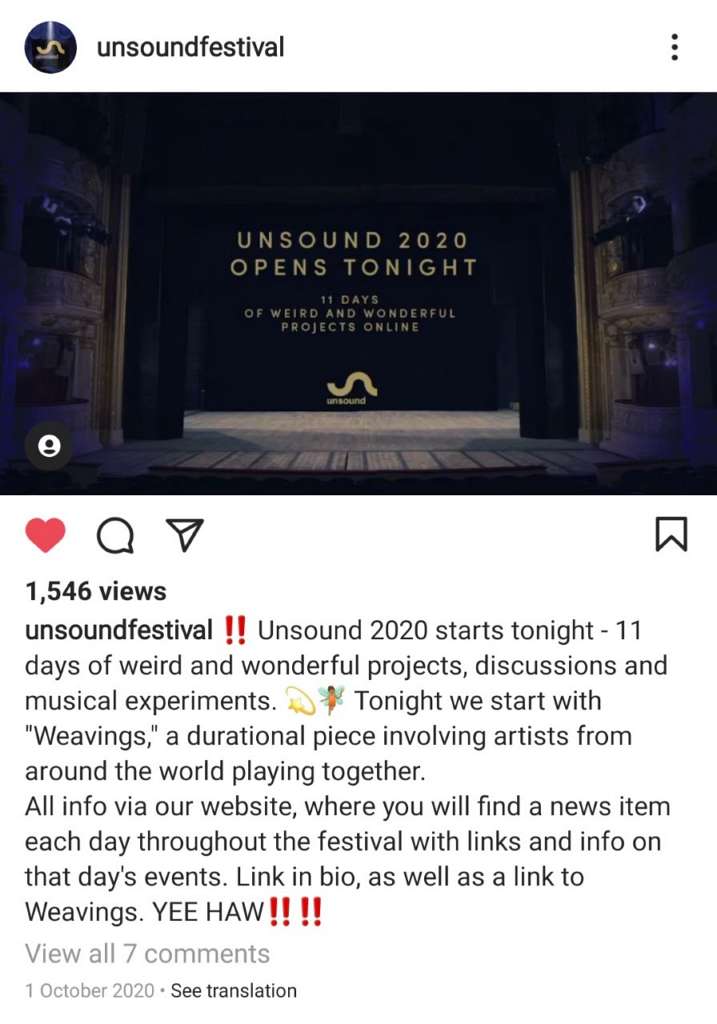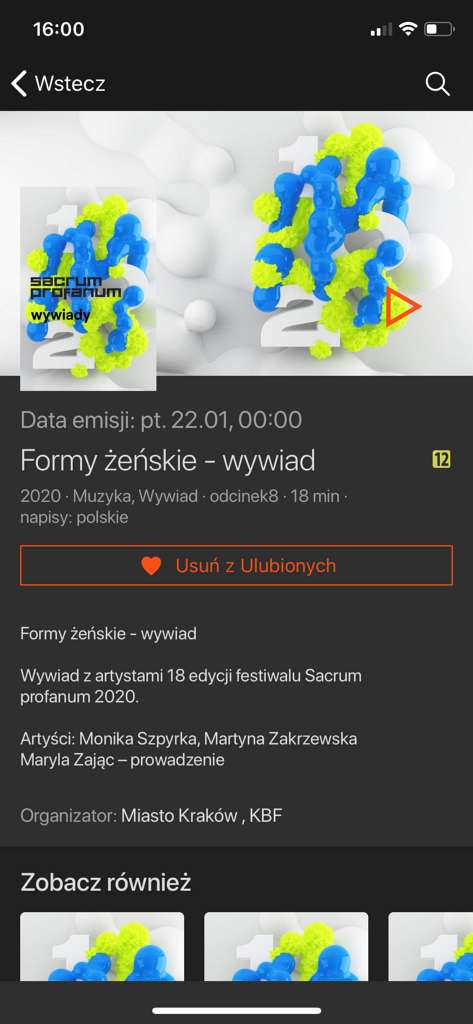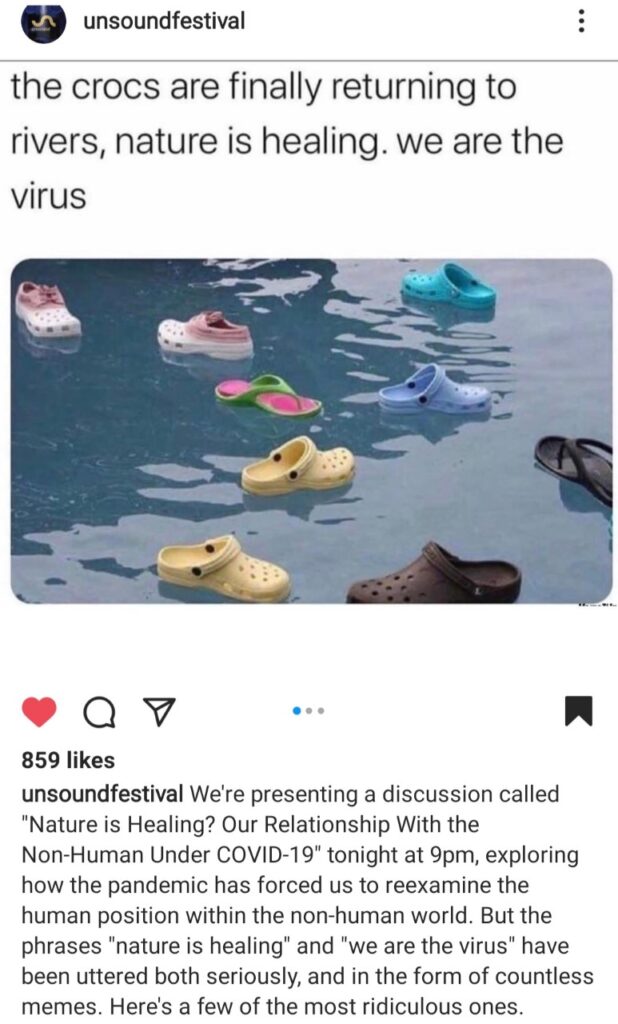Karolina Golemo and Marta Kupis
Uniwersytet Jagiellonski, Poland
A year ago, in March 2020, Poland entered the first lockdown, which influenced the cultural sector in general and the music festival scene specifically. At the time, it was still believed that the critical situation would not last long, leaving festival organisers in a state of uncertainty as to how they should proceed with the events planned for 2020. Cracow a member of UNESCO Creative Cities Network with its nearly 100 festivals organised annually, many on an international scale, had to face these new circumstances. The organisers were forced to cancel or redefine the form of their events, as well as look for new ways of communicating with audiences. The three festivals that we observed (EtnoKraków/Crossroads, Sacrum Profanum, and Unsound) responded to the pandemic circumstances in a different way.
Following the governmental restrictions, the EtnoKraków/Crossroads festival postponed the date of the 2020 edition a couple of times, waiting until the last moment to decide when, where and how to organise it. Eventually, it was delayed for two months and involved visible limitations due to sanitary reasons, resulting in a hybrid form: live concerts with sanitary restrictions were combined with radio transmissions of previous editions’ concerts, and online streaming via Facebook and on their webpage. The Unsound Festival’s first reaction was to cancel the 2020 edition, but shortly later the organisers decided to change its format, to launch a crowdfunding campaign, and to go online with a different programme encompassing less music and more talks. The theme of the 2020 edition was “Intermission”, referring to a break caused by the pandemic, “a period starkly separating before from after”.

Following the first governmental announcement about COVID -19 restrictions concerning the festival sector, the Sacrum Profanum festival organisers made a decision about a total change of their festival form, treating it as an occasion for experimentation. They moved the whole event to the virtual space (using a special VOD platform ‘Kraków Play’ created to share cultural content during the pandemic), but with a brand new cycle of live concerts pre-recorded in various festival locations specifically for the 2020 edition, with artists and sound technicians present on the spot. The “only” missing element was the physical presence of the public. The duration of the event was also prolonged from one week to one month, turning it into a “slow festival”, as stated by the organisers. The examples of the above mentioned festivals shows that there are different models of a “hybrid festival” where the “hybridity” may concern: the space, transmission channels, geographic dimension, and content.

Although the “hybrid events” are not a completely new phenomenon, it is only now that they become necessary to keep festivals from falling apart during the pandemic. Rather importantly, the majority of respondents to Event Manager Blog’s survey declared that they wanted to maintain the online audience after the pandemic crisis is over. If hybrid events are indeed here to stay, it seems important to study how they are experienced by all participants of the festival community: artists, organisers, and last by not least, the audience.
Hybrid festival spaces may be described as spaces where different types of festival experience can occur simultaneously: live/real and virtual; collective/shared and individual; public and private/intimate. The issue of hybrid spaces as domains of intercultural relations had already been studied before the COVID-19 emergency changed the understanding of participation in culture and cultural exchange. Leszek Korporowicz (2016; 2017) claims that hybrid spaces are areas of constant transgressions and creative potential, especially if they also allow for different cultures to interact. Moreover, this transgressive potential is also linked to the technological characteristics underlying the virtual-/cyber-space, which in turn influence the mental and social states of their users. Most importantly, they are spaces where “physical distances lose their importance in favour of semiotic ‘distances’”. As a result, the very understanding of space – especially in its symbolic and informational aspects – changes, becoming increasingly “contextual, hybrid and multi-dimensional”. Korporowicz (2016:19) suggests that all of these characteristics allow not only for the broadening of cultural spaces’ borders, but made them very easy to cross: “They are full of “holes” or “gateways,” and, in equal measure, overlays and synergies that shift in the world of global information flow, and consequently of a new configuration of communities defined by their participation in the network society” (Ibid.: 20). Are music festivals, especially those taking place in hybrid spaces, such gateways? Another definition of hybridity can be provided in the context of the mass media. The term “hybrid” refers there to a complex intermedia dynamic between mainstream news media and social media, as well as the complicated circulations between messages and actors, and the recombination of media on a variety of media platforms. Sumiala et al (2016: 98) describe hybrid media events as “media events whose significance for media professionals, politicians, and non-elites is being reconfigured by the growth of social media”. The hybrid festivals’ formula can also be analysed through the concept of “time-space distanciation” introduced by Anthony Giddens (1991). According to him, the advance in communication technologies caused the stretching of social relations and made the remote interactions a significant feature of everyday life. As a consequence, the interconnectivity and interdependencies have increased, as can be seen from the example of the online festival communities, connecting people from many corners of the world.
The Unsound Festival’s organisers made a direct reference to hybrid realities by including the theme of hybridity in one of the debates during Unsound Lab, a special workshop for people wishing to start a career in music management. The discussion “Online/offline – hybrid possibilities” focused on the immaterial future of music and the role of streamed music events. They also organised an experiment with the participation of the audience and invited people to place multiple online-devices (including those archaic ones) around their apartments and simultaneously listen to the same performance. The idea was to produce a completely new sonic effect, a “Corona-style multichannel-audio experience”.

The observation of the 2020 editions of the selected festivals allows us to enumerate the following COVID -19 challenges and opportunities the organizers were and are still dealing with:
A) Reorganization and new uses of the festival space, including the appearance of cyber spaces, “time-space distanciation”, and a blurring of private/public sphere(s). On a more theoretical level, it can be said that in hybrid and virtual events, all or part of the role usually fulfilled by space is overtaken by time: rather than by meeting in the same place, any sense of community is created by mass communication at the same time. The example of the Sacrum Profanum organisers showed a fresh attitude to the virtual space: they tried to treat the network as a place of artistic activities, rather than merely the means of reflecting them. The new formula allowed them to showcase concerts in interiors that could not be used in the traditional model. This has given them the impetus for change: in future editions, they plan to reduce the number of listeners in order to give them the opportunity to participate in smaller events taking place in original locations (beyond mass reach), as well as to go to the backstage and see how the event is produced in real time.
B) New forms of organiser-artist-audience cooperation where the festival experience is turned into a “mediated experience”. The artists and debate participants had no or a limited ability to interact with the audience or gauge their reactions, especially in the case of pre-recorded performances in the Sacrum Profanum festival. Consequently, the organisers had to explore the online mediums’ affordances to deal with this barrier: for Unsound, this meant the occasion to finally fulfil their long term plan of publishing a book of essays and an album of songs recorded for the festival – both of which are available in the traditional (indeed, vinyl!) formats, as well as digital downloads. However, probably the most interesting examples of hybridity in performance came as a direct result of a Coronavirus infection suffered at the time by the festival’s artistic director, Jan Słowiński. Firstly, he had to coordinate a live event entirely virtually, which may be usual in the preparation stage, but is less common during the festival. Secondly, his wife Joanna, who is also a singer and was isolating with her husband, participated in the performance with the Sokół Orchestra via an online connection . This also meant that the musicians had to coordinate their live playing with her virtual vocals – and it must be stated that they did this flawlessly.
The pandemic crisis had its financial aspect which proved quite painful for the cultural sector, though it must be noted that the festivals we analysed were in a relatively good situation, as they do not rely fully on ticket sales. Still, the usual financing from central and municipal administration was largely cut, leading the organisers to look for alternative sources of money. In Unsound’s case this meant an online crowdfunding action, which turned out to be very successful, showing their festival audience’s strong sense of solidarity with the event. On the other hand, the organisers of Sacrum Profanum Festival decided to work exclusively with Polish artists to support native performers, as the individual artists were also affected by the pandemic restrictions.
C) New understanding of openness/exclusion. Online events are available theoretically for a limitless public, but in practice participation is restrained by technological skills and resources. Among those who do have them, new patterns of accessibility can be observed: the virtual/hybrid concerts are available for people who would be excluded from the traditional live format (especially people with disabilities and those who can’t afford to travel to festival site). Additionally, there may be increased participation from people who would usually be indecisive on whether they want to go to a given event, as monetary and time costs are much lower in such circumstances (the case of Sacrum Profanum, a festival of experimental and modern classical music).
D) Rethinking active/passive participation. While the intrusion of the festival into private homes has its disadvantages, it may also pose an opportunity for the audience to take a more active part in the event’s life. The most striking example of this is the case of Unsound being crowdfunded by its fans. While some prosumptive behaviours – in the sense of consuming/experiencing the concert through the audience’s own creations and activities – are possible and indeed frequent in traditional, live concert circumstances, in the hybrid situation they become the only widely available way to engage (or at least feel engaged) with the artists and other viewers. Whether it is a photograph of oneself while watching the event, a comment under the transmission or a handmade painting on the festival theme, the real-time online audience activities become much more important for the maintenance of festival atmosphere. The Sacrum Profanum festival also provided other forms of online interaction with the public: Cracow’s soundwalks for children, DIY digital workshops on making musical instruments or an interactive composition with alternative variations to be chosen/voted by the audience watching the event via Play Kraków platform.
E) New opportunities for (virtual) cultural exchange. The example of the Unsound festival audience showed that its online actions – on Facebook and Discord – were aimed at maintaining a sense of community. Live commentators are eager to share where they come from and non-Polish speakers are usually welcomed by local participants, often offering help in “moving around” the virtual stages. It can be seen as a realisation of Manuel Castells (2010) network society, with the festival itself serving as the central “node” of communication, surrounded by many multidirectional exchanges between the participants from different cultures.
Probably the most profound change that emerges in the festival sphere due to the emergence of hybrid festivals is a change of the very meaning of “liveness”. A festival can be a “live” event even in a virtual space, where the interactions within the festival community and real-time reactions of the public occur through digital channels.
As Paweł Potoroczyn – an EFA member and culture manager – states, “festivals are ideas in work, and not brands”. The emergency situation and atypical conditions often make space for new (courageous) ideas, experiments, and “extravagance”, as was manifested during the restrictions during the time of the pandemic. The current circumstances remind us that the concept of ‘liminality’ is inscribed into the phenomenon of (music) festivals, and especially to festival communities. The new festival formats that appeared as a consequence of Covid -19 are unquestionably a manifestation of organisational creativity, even though for some researchers and festival sector specialists, like Robert Piaskowski, nothing can replace the real, material (physical) event and that “emotion that spreads in the crowd and not only in the network”.
References
Castells, M. (2010) Społeczeństwo sieci (M. Marody (trans.); 2nd ed.), Warszawa.
Giddens, A. (1991) Modernity and self-identity: Self and society in the late modern age. Cambridge: Polity Press.
Korporowicz, L. (2017). Extended cultures : towards a discursive theory of hybrid space. In A. Duszak, A. Jabłoński, & A. Leńko-Szymańska (Eds.) East-Asian and Central-European encounters in discourse analysis and translation, Instytut Lingwistyki Stosowanej, WLS UW, pp. 13-31.
Korporowicz, L. (2016) ‘Intercultural Space’, Politeja 5 (44): 17-33.
Solaris, J. (2020) The Future of Events Is Definitely Hybrid: What Will They Why Hybrid Events Are Here to Stay. https://www.eventmanagerblog.com/future-is-hybrid-events
Sumiala, J., Tikka, M., Huhtamäki, J., & Valaskavi, K. (2016) ‘#JeSuisCharlie: Towards a Multi-Method Study of Hybrid Media Events’, Media and Communication, 4 (4): 97-108.

